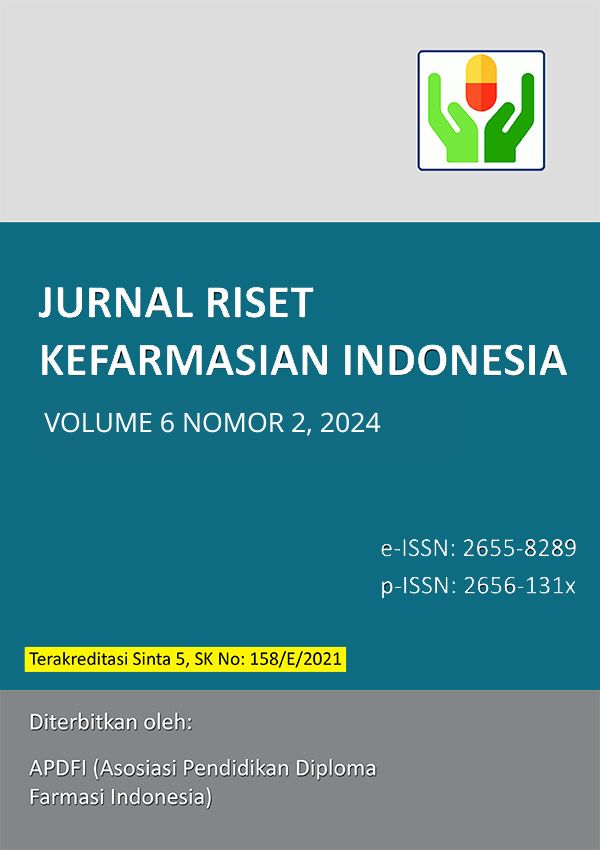PERBANDINGAN SIFAT FISIK SEDIAAN LILIN AROMATERAPI KOPI ROBUSTA (Coffea canephora) DAN KOPI ARABIKA (Coffea arabica)
DOI:
https://doi.org/10.33759/jrki.v6i2.487Keywords:
Aromatherapy, Physical properties of candle, Robusta Coffee (Coffea canephora), Arabica Coffee (Coffea arabica)Abstract
Coffee is a plant that has benefits that can reduce stress when applied to aromatherapy candles. There are two most popular types of coffee: robusta coffee (Coffea canephora), which has a more intense taste and aroma, and arabica coffee (Coffea arabica), which has a lighter taste and aroma. This research aimed to compare the physical properties of robusta coffee (FR) and arabica coffee (FA) aromatherapy candle preparations. The formulation of aromatherapy candle preparations had a paraffin base (10%), stearin, and composition of coffee oil and coffee powder, 2% and 2.5% for formula 1 and 10% and 10% for formula 2. Organoleptically, the candle was solid, not cracked, and had the color brown to black. The aroma of formula 1 was weak, and the aroma of formula 2 was strong, typical of coffee aroma. The burning time for candles with an average weight of 8.52 grams for each group for formulas 1 and 2 FA was 11.45 minutes and 10.04 minutes, while FR was 11.57 minutes and 9.57 minutes. The melting point for aromatherapy candles was an average of 52–54 °C. This value meets the criteria for candle preparations based on SNI. A comparison of the formulas for aromatherapy candle preparations had a significant effect on the weight and burning time of aromatherapy candle preparations. Overall, the coffee candle aromatherapy meets the SNI criteria for candle preparations.
Downloads
References
Aisyah, S., Effendi, Z., & Hawalis, S. (2020). OPTIMASI PEMBUATAN LILIN AROMATERAPI BERBASIS STEARIC ACID DENGAN PENAMBAHAN MINYAK ATSIRI CENGKEH (SYZYGIUM AROMATICUM). Jurnal Hexagro, 4. https://doi.org/10.36423/hexagro.v4i1.362
Alharbi, W. D. M., Azmat, A., & Ahmed, M. (2018). Comparative effect of coffee robusta and coffee arabica (Qahwa) on memory and attention. Metabolic Brain Disease, 33(4), 1203–1210. https://doi.org/10.1007/s11011-018-0230-6
Caporaso, N., Whitworth, M. B., Cui, C., & Fisk, I. D. (2018). Variability of single bean coffee volatile compounds of Arabica and robusta roasted coffees analysed by SPME-GC-MS. Food Research International, 108, 628–640. https://doi.org/10.1016/j.foodres.2018.03.077
Dippong, T., Dan, M., Kovacs, M. H., Kovacs, E. D., Levei, E. A., & Cadar, O. (2022). Analysis of Volatile Compounds, Composition, and Thermal Behavior of Coffee Beans According to Variety and Roasting Intensity. Foods, 11(19), Article 19. https://doi.org/10.3390/foods11193146
Dumanauw, J., Maramis, R., Rindengan, E., & Gansalangi, G. (2022). FORMULASI LILIN AROMATERAPI MINYAK LAVENDER (Oleum lavandala) DAN MINYAK MAWAR (Oleum rosa). Prosiding Seminar Nasional Kefarmasian Program Studi Farmasi FMIPA Universitas Sam Ratulangi, 1(1), Article 1.
Ermawati, N., & Sari, E. F. (2023). FORMULASI DAN EVALUASI SEDIAAN LILIN AROMATERAPI DARI MINYAK ATSIRI JAHE DAN LEMON DENGAN MINYAK JELANTAH SEBAGAI BASIS. Journal Pharmacopoeia, 2(1), Article 1. https://doi.org/10.33088/jp.v2i1.362
Erskine, E., Gültekin Subaşı, B., Vahapoglu, B., & Capanoglu, E. (2022). Coffee Phenolics and Their Interaction with Other Food Phenolics: Antagonistic and Synergistic Effects. ACS Omega, 7(2), 1595–1601. https://doi.org/10.1021/acsomega.1c06085
Fitri, K., Hafiz, I., Safitri, N., & Ginting, M. (2020). Formulasi Kombinasi Minyak Nilam (Patchouli oil) dan Minyak Mawar (Rose oil) pada Sediaan Lilin Aromaterapi sebagai Relaksasi. Jurnal Dunia Farmasi, 4(2), 90–98. https://doi.org/10.33085/jdf.v4i2.4544
Hawiset, T. (2019). Effect of one time coffee fragrance inhalation on working memory, mood, and salivary cortisol level in healthy young volunteers: A randomized placebo controlled trial. Integrative Medicine Research, 8(4), 273–278. https://doi.org/10.1016/j.imr.2019.11.007
Isma, F. N., Dianita, P. S., & Kusuma, T. M. (2023). Formulasi dan uji hedonik lilin aromaterapi minyak atsiri lengkuas (Alpinia galanga (L) Wild). Borobudur Pharmacy Review, 3(1), Article 1. https://doi.org/10.31603/bphr.v3i1.7596
Lesmana, F., & Marini, M. (2020). FORMULASI SEDIAAN LILIN AROMATERAPI DARI MINYAK BIJI KOPI ROBUSTA (Coffea robusta) UNTUK PENGHARUM RUANGAN. HERBAPHARMA : Journal of Herb Farmacological, 2(2), 40–46. https://doi.org/10.55093/herbapharma.v2i2.147
Lestari, I., Prabandari, S., & Febriyanti, R. (2021). KOMBINASI EKSTRAK ETANOL BIJI KOPI ARABIKA (Coffeaarabica L.) DAN COKLAT (Theobromacacao ) PADA PEMBUATAN LILIN AROMATERAPI [Diploma, Politeknik Harapan Bersama Tegal]. https://repository.poltekharber.ac.id/169/
Li, D., Li, Y., Bai, X., Wang, M., Yan, J., & Cao, Y. (2022). The Effects of Aromatherapy on Anxiety and Depression in People With Cancer: A Systematic Review and Meta-Analysis. Frontiers in Public Health, 10, 853056. https://doi.org/10.3389/fpubh.2022.853056
Mukhlishah, N., Amran, A., & Ratnasari, Y. (2020). MUTU ORGANOLEPTIK KOPI ARABIKA BERDASARKAN LAMANYA WAKTU PENYANGRAIAN: Organoleptic Quality of Arabic Coffee Based on the Long Time of Flighting. Jurnal Agrisistem, 16(1), Article 1.
Oktarina, T. F., Prabowo, W. C., & Narsa, A. C. (2021). Penggunaan Soy wax dan Beeswax sebagai Basis Lilin Aromaterapi: Use of Soy wax and Beeswax as Aromatherapy Candle Base. Proceeding of Mulawarman Pharmaceuticals Conferences, 14, 307–311. https://doi.org/10.25026/mpc.v14i1.589
Pachimsawat, P., Tangprasert, K., & Jantaratnotai, N. (2021). The calming effect of roasted coffee aroma in patients undergoing dental procedures. Scientific Reports, 11(1), Article 1. https://doi.org/10.1038/s41598-020-80910-0
Sulhatun, S., Sarah, S., Masrullita, M., Sylvia, N., & Ginting, Z. (2023). PENGARUH PERBANDINGAN MINYAK KEMIRI DAN MINYAK BUNGA LAVENDER TERHADAP SIFAT LILIN AROMATERAPI FORMULASI LILIN AROMATERAPI BERBASIS MINYAK KEMIRI DENGAN PENAMBAHAN MINYAK BUNGA LAVENDER. Jurnal Teknologi Kimia Unimal, 12, 12. https://doi.org/10.29103/jtku.v12i1.11610
Tumanggor, R. D., Kasfi, A., Baiti, N., & Nasution, D. L. (2022). The Effect of Coffee Aromatherapy on Reducing Fatigue and Stress Levels of Female Caregivers Caring for the Elderly in Hospitals. Open Access Macedonian Journal of Medical Sciences, 10(G), 382–387. https://doi.org/10.3889/oamjms.2022.9216
van Dam, R. M., Hu, F. B., & Willett, W. C. (2020). Coffee, Caffeine, and Health. The New England Journal of Medicine, 383(4), 369–378. https://doi.org/10.1056/NEJMra1816604
Yuliana, B., Makkulawu, A., & Amal, A. R. (2023). Formulasi dan Uji Kestabilan Fisik Lilin Aromaterapi Minyak Atsiri Bunga Melati (Jasminum sambac L). Journal Syifa Sciences and Clinical Research, 5(1), Article 1. https://doi.org/10.37311/jsscr.v5i1.18874
Downloads
Published
Issue
Section
License
Copyright (c) 2024 Jurnal Riset Kefarmasian Indonesia

This work is licensed under a Creative Commons Attribution-NonCommercial-ShareAlike 4.0 International License.












